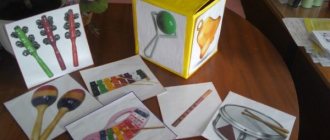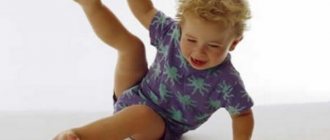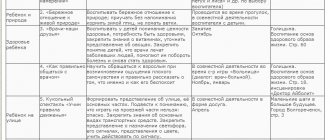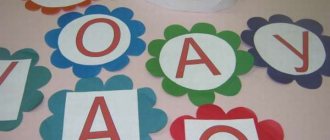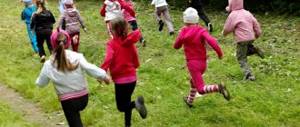Didactic game "Fishing" for children from 3 years old
Didactic game for kindergarten
Didactic game "Fishing"
The game “Fishing” can be used by educators, both for children’s independent play and for joint activities with children, as well as parents of preschool children.
The game can be played by children aged 3 years and older, either alone or in groups of 2 to 4 people. This game, on the one hand, will give children the joy of “communication” with water, will promote relaxation, on the other hand, it can help solve some educational and educational problems: • develop coordination of hand movements, • develop strong-willed personality traits (patience, perseverance, perseverance ), • consolidate certain mathematical knowledge in children of different age groups in a playful way, • practice coordinating words in phrases and sentences when working together with a teacher, • activate the child’s speech. Game material. To play, you need a plastic basin (bowl) for water.
The game uses the inner caps of plastic sunflower oil bottles and Tetra Pak packages of dairy products as fish.
Fishing rods can be made from “waste” material: tubes, sticks. A thread or thin rope is used as a “fishing line”. Hook – paper clip (preferably metal, if the paper clip is colored, then you need to make a weight from plasticine).
The purpose and objectives of the didactic game “Fishing” were presented above. Let me clarify what mathematical knowledge can be consolidated with children in combination with activating the vocabulary during individual work: 1. Reinforce the concepts of “big” and “small”. • Give the child a task: catch a big (small) fish. • Ask: “What size fish did you catch?”
2. Practice counting: • Ask: “How many fish did you catch (big, small, red, white)?”
3. Practice ordinal counting: • Ask: “What is the order of the white (small) fish?”
4. Fix the composition of the number from two smaller ones: • For example, catch 2 large and 3 small fish (yellow, red). • How many did you catch? • Which 2 smaller numbers made up the number 5?
5. Practice coming up with arithmetic problems: • Think of a problem to yourself. For example, a child caught 3 red fish and 2 yellow ones. Or: a child caught 4 fish, gave one to the cat (the cat’s toy is nearby), etc. • Come up with a problem about a friend, if Vasya caught 1 big fish and 2 blue fish, etc. • Come up with a problem about yourself and a friend, if you caught 4 fish, a friend - 3 fish, etc. The game “Fishing” can be played outdoors in the summer.
We recommend watching:
Didactic game for preschoolers for the development of fine motor skills Reviews of didactic games for children of primary preschool age Didactic game for kindergarten “Colored Domino” Crossword puzzles for teaching children to read and write. Senior preparatory group
Similar articles:
DIY didactic toy. Step-by-step master class with photos
Do-it-yourself didactic games made from waste material
Do-it-yourself didactic game for preschoolers “In the world of animals”
Do-it-yourself didactic game for kindergarten on the topic “Sports”
Using didactic games in kindergarten classes
Universal manual – game “Big Fishing”
- February 25, 2013
Competition "Golden Handicraft - 2012"
Nomination "Magic Needle"
I would like to bring to your attention my favorite universal guide – the game “Big Fishing”. Children from 4 to 7 years old love to play it.
Tasks:
- Develop motor skills and hand coordination.
- Develop sensory perception of color and shape.
- Form elementary mathematical concepts.
- Expand words knowledge.
- Improve the lexical and grammatical structure of speech.
- Develop coherent speech.
- Literacy training (familiarity with letters, sound analysis of words, dividing words into syllables, etc.).
The manual can be used in almost any class. The game is easy to make, use and store.
Job description:
Lake
For knitting you will need: Hook No. 6; 4 or 4.25 and 3.5; 150 g blue yarn of medium thickness. I knitted a lake from threads and assembled it with a string.
The knitted “pond” performs two tasks here: when unfolded, it is a water bottle, and if you tighten the lace, it becomes a handbag in which it is convenient to store the game.
Lace.
Cut a piece of green yarn 4 times the diameter of the pond. Cut it into 3 equal parts. Place them together and tie a knot at one end, leaving a little thread for the fringe. Weave a tight braid. Thread a lace between the posts of the 7th row every 3 dc. Tie both ends together with a knot.
Fishes.
Knit 33 large fish with crochet number 4 or 4.25, 7 medium-sized fish, 7 small-sized fish (place everything in a bag - a lake, it’s so convenient to store all the fish at the same time, a fishing rod with a magnet on a fishing line, knitted fish of different colors and sizes). An iron loop is sewn onto the fin of each fish so that a magnet can be attached.
Fishing rod.
Taken from the game the ryabalka, at the end of which there is a magnet.
The game also comes with cards with various pictures (letters, numbers), each card has a loop to attach to the fish.
Game rule: The child uses a fishing rod to “catch” a fish from the lake, name the picture and complete the task.
Game options:
- D/game “Catch a fish. What size is it?”;
- D/game “What color is the fish?”; “What else comes in this color?”;
- D/game “Vegetable garden”;
- D/game “Who lives where?”;
- D/game “Where, whose mother? ";
- D/game “Automation of sounds in speech” (using example [c]);
- D/game “Catch a fish and name what geometric figure is drawn on it”;
- D/game “Catch a fish with a number and match the number with the number of objects”;
- D/game “Fourth wheel”;
- D/game “One - many”;
- D/game “He, she or it”;
- D/game “Name it affectionately”;
- D/game “What has changed”;
- Didactic games for teaching literacy;
- D/game “Find a pair”.
Used Books:
- L.Yu. Pavlova. Collection of didactic games.
- A.K. Bondarenko Didactic games in kindergarten.
- E.N.Panova. Didactic games - classes in preschool educational institutions.
Internet resources:
- https://moipetelki.ru/blog/for_kids/razvivayushhaya-igrushka-rybalka/
Author: Buzanova Valentina Aleksandrovna, teacher of the second qualification category, 21 years of teaching experience, winner of the city competition of teaching aids, MBDOU TsRR - d/s "Buratino", Kogalym, Tyumen region, Khanty-Mansi Autonomous Okrug - Yugra.
Playing with water
You can make the game even more interesting if you place the fish in the water. In the summer you can “release” the fish into the inflatable pool. A basin or bathtub is suitable for playing at home. Lay a tablecloth so that the child does not wet the floor. The essence of the game remains the same. It will be more interesting for a little fisherman to play with water. He gets acquainted with its physical properties. Observes how objects move on the surface and float. Pulling things out of the water is a little more difficult. When the hook is touched, the fish is pushed to the side and swims away. Therefore, the baby develops diligence, dexterity and coordination. Attention: children should play with water under adult supervision.
Group game
Several children can play Catch the Fish at once. Then you will need to prepare more items for fishing. The point of the game is to catch as many fish as possible in a short time. Play a short piece of music; when it ends, time stops. If there is no music, then the presenter can give a minute, and then clap his hands loudly. The clap means stop and the end of the game. At the end, the presenter counts the number of fish and announces the winner. To make the rest of the kids less upset, you can introduce prizes. Example: fisherman Vanya collected 9 fish and took first place. Fisherman Stas caught 6 fish and gets second place.
Playing with iron objects
This type of game is more suitable for children 3 years old and older. Instead of a hook, we attach a magnet to the fishing rod. You can glue a magnet to the hook itself. We lay out iron objects on the floor that the baby can magnetize. Try gluing magnets to plastic or rubber toys. They should not be too small so that the child swallows them. Cut out cards from colored cardboard. Glue one coin to each card with strong glue. This type of game develops little coordination, but introduces the property of a magnet. Fine motor skills work here, because the catch must be removed carefully so as not to tear the coin off the cardboard. The child can learn colors using color cards.
Didactic game “Catch a fish”
Didactic game “Catch a fish”
Author of the game:
teacher-speech therapist Parkhomenko Nadezhda Sergeevna.
Item:
speech therapy (speech correction for children of senior preschool age).
The game is designed for children of senior preschool age (5-7 years old),
includes two options depending on the goal set by the speech therapist teacher.
Purpose of the game:
improvement of phonemic processes in children of senior preschool age with deficiencies in the phonetic-phonemic aspect of speech.
1st option:
Tasks:
teach children to listen and hear spoken speech, distinguish words that are similar in sound composition and choose a picture in accordance with the word they hear, develop coordination of finger movements.
Equipment:
magnetic fishing rod and picture fish in series: com, catfish, crowbar, house;
poppy, mat;
cook, cat, com;
poppy, cancer, varnish, tank.
.
Progress of the game:
An adult places picture fish with similar-sounding words (series) in front of the child:
com, catfish, scrap, house;
poppy, mat;
cook, cat, com;
poppy, cancer, varnish, tank.
- Today you and I are fishermen. We will catch fish. Listen carefully and catch a fish with the picture that I will name.
The adult names the object, and the child catches the corresponding picture with a magnetic fishing rod and names it. The adult monitors the correctness of the task and praises the child for completing the task correctly.
After the child has caught all the fish, the adult offers to look at his catch and once again name the pictures depicted on the fish.
There can be two fishermen, in which case the game is competitive. The one who completes the task without errors wins.
2nd option:
Tasks:
teach children to distinguish between the sounds [S] and [W], to develop coordination of finger movements.
Equipment:
magnetic fishing rod, fish with pictures with sounds [S], [W]: fox, dog, snowman, sleigh, airplane, elephant, pine cone, mouse, horse, cherries, car, bear.
Progress of the game:
Today you and I are fishermen, we will catch fish and determine what sound is in the name of the picture on the fish - [S] or [W]? Fish with pictures on [S] are on the left, and fish with pictures on [W] are on the right. The “fisherman” catches each fish with a fishing rod, names the picture, determines which of the given sounds is heard in the word, and arranges the “catch” in two rows.
After all the fish are caught, the “fisherman” once again names all the pictures in one row, then all the pictures in the second row. The adult controls the correctness: the presence of the desired sound in the title of the picture and the correctness of its pronunciation.
To create the game we used:
colored cardboard, drawn fish templates, paper clips, a fishing rod with a magnet at the end, object pictures containing the group(s) of sounds being practiced (the second option is the sounds [S] and [Ш], all pictures were found on the Internet , printed on a color printer, cut out and glued onto fish templates.
